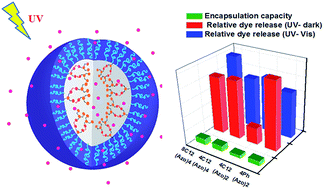Hydrophobic dendrons with different numbers and positions of azobenzenes as well as different groups – benzyl and dodecyl, on the periphery were synthesised and attached to poly(ethylene glycol) using copper-catalysed azide–alkyne cycloaddition to obtain linear-dendritic copolymers. Self-assembly of the polymers in aqueous solution was characterised using dynamic light scattering (DLS), transmission electron microscopy (TEM) and critical micelle concentration (cmc). Formation of H-aggregates during micellisation was shown for polymers with a higher number of azobenzene units. Photoisomerisation of azobenzene in the assemblies was studied and the rate constant of thermal photoisomerisation was calculated. Release of hydrophobic dye Nile red upon photoisomerisation of azobenzene occurred without disruption of micellar aggregates. Dye release varied with the pathway – thermal or visible light irradiation, followed for cis–trans isomerisation. The encapsulation capacity of the micelles and extent of dye release in either pathway were found to be influenced by the dendron structure. A polymer with a lower number of azobenzenes and aliphatic periphery on the dendron showed significantly different behaviour than polymers with a larger number of aromatic units.

